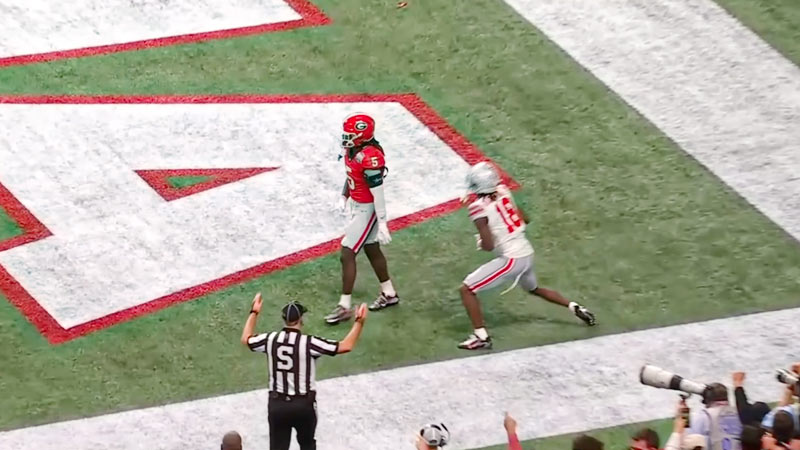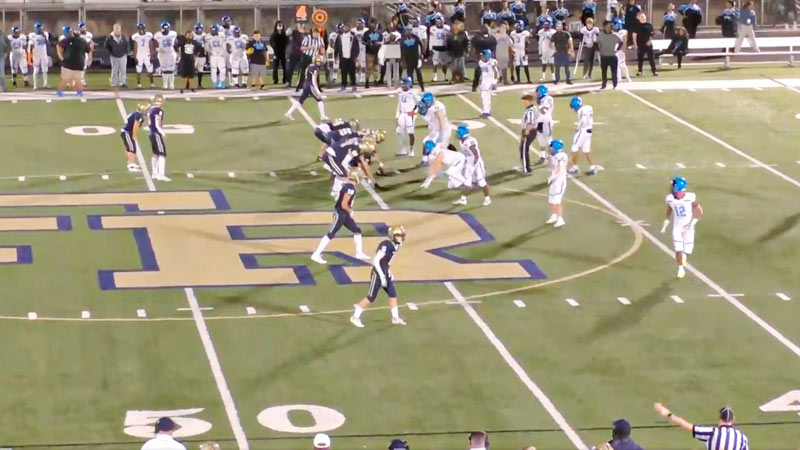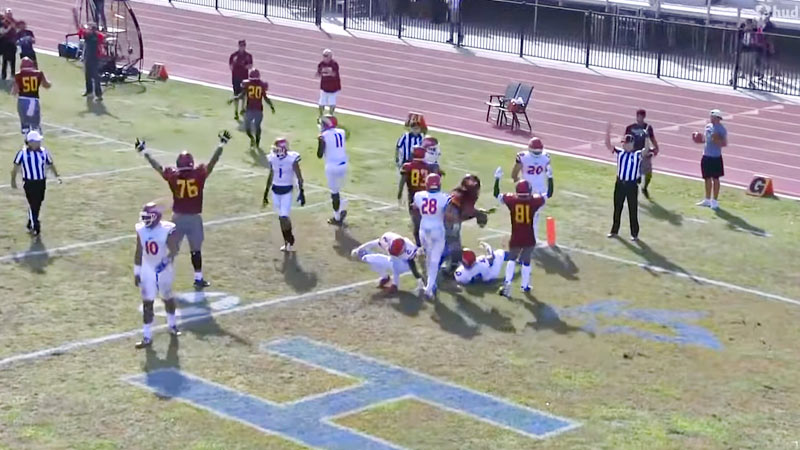In the fast-paced and electrifying world of American football, where strategy, athleticism, and raw emotion converge, the game’s integrity and fairness hinge on the precision and expertise of its officials. One such unsung hero on the field is the football side judge.
Often overshadowed by the players and the more prominent referees, the side judge’s role is fundamental to ensuring fair play, enforcing the rules, and contributing to the seamless flow of the game.
In this blog post, we’ll delve into the world of the American football side judge, exploring their responsibilities, impact, and the skills they bring to the gridiron. So, stay focused.
Who Is the Side Judge in Football?
The side judge in American football is one of the seven on-field officials responsible for officiating the game. Positioned on the sideline, this official primarily focuses on the actions taking place on their assigned side of the field.
The side judge assists in enforcing rules related to player positioning, pass interference, and other infractions that may occur on their designated side. They also play a crucial role in tracking the game clock, ensuring proper timing and coordination during plays.
Additionally, the side judge assists the head referee and other officials in making accurate calls by providing input on plays and penalties.
Duties of a Football Side Judge
The football side judge, one of the game’s seven on-field officials, has several key responsibilities during a match:
Offside Calls
The side judge monitors the line of scrimmage on their designated side of the field, specifically focusing on offside violations by defensive players. They ensure that defensive players do not encroach on the neutral zone before the ball is snapped.
Pass Coverage
Responsible for observing pass plays on their side of the field, the side judge helps identify and penalize defensive pass interference, illegal contact, and other infractions that may occur during passing plays.
Player Positioning
The side judge keeps an eye on player formations and positioning on their side, ensuring that the offense lines up within the rules and that defensive players are not crowding the line of scrimmage or otherwise violating positioning rules.
Out of Bounds
Along with the head linesman, the side judge oversees plays along the sideline, including determining if a player stepped out of bounds, whether a catch was made inbounds, and when a player crosses the sideline.
Game Clock Management
The side judge assists in tracking the game clock, play clock, and timeouts, helping to ensure that game timing proceeds accurately.
Signals and Communication
Like other officials, the side judge uses specific hand signals to communicate decisions and penalties to players, coaches, and spectators. They also communicate with the head referee and other officials to discuss calls and coordinate game management.
Observing Kicking Plays
During punts and field goal attempts, the side judge monitors actions at the line of scrimmage and the coverage of kicks on their side of the field.
Assisting Head Referee
The side judge supports the head referee in making accurate calls by providing input and information based on their perspective of plays and potential rule violations.
Player Safety
The side judge helps enforce rules related to player safety, such as late hits, unnecessary roughness, and other dangerous plays.
Reviewing Instant Replays
In some football leagues with video review systems, the side judge may be involved in reviewing plays to determine if calls on the field should be upheld, overturned, or modified based on available video evidence.
The side judge’s duties contribute to the overall fairness, accuracy, and smooth progression of the game by ensuring that the rules are upheld and that both teams have an equal opportunity to compete.
Skills of a Football Side Judge

A football side judge must possess a combination of skills and attributes to effectively fulfill their role as an on-field official. These skills include:
Rule Knowledge
A thorough understanding of the rules and regulations of football is crucial. The side judge must know the intricacies of the game to accurately enforce penalties and make correct calls.
Field Awareness
The ability to maintain a clear view of their designated side of the field and quickly identify infractions, player positioning, and key plays is essential. Field awareness helps them anticipate potential issues and react promptly.
Positioning
Proper positioning along the sideline ensures that the side judge has the best vantage point to observe plays, players’ actions, and potential rule violations. They need to adjust their position as plays develop to maintain optimal visibility.
Communication Skills
Effective communication is essential for interacting with players, coaches, fellow officials, and spectators. The side judge needs to convey decisions confidently using hand signals, verbal communication, and composure under pressure.
Decision-Making
Quick and accurate decision-making is vital during fast-paced plays. The side judge must assess situations, interpret actions, and make split-second judgments regarding penalties, player interactions, and ball possession.
Teamwork
Football officiating is a collaborative effort. The side judge must work closely with other officials on the field, coordinating actions, discussing calls, and ensuring consistent enforcement of rules.
Confidence
Displaying confidence in their calls and decisions helps maintain control over the game and gain the respect of players, coaches, and fans. A confident side judge is less likely to be challenged by participants.
Calm Under Pressure
Football games can become intense and emotional. The side judge should remain composed and focused even in high-pressure situations, ensuring that emotions do not influence their judgment.
Physical Fitness
Football officiating requires being in good physical condition to keep up with the fast-paced nature of the game. The side judge needs to move quickly along the sideline to maintain optimal positioning.
Adaptability
Circumstances in a game can change rapidly. The side judge must adapt to different game situations, weather conditions, and varying levels of play to ensure consistent officiating.
Attention to Detail
Small details can have a significant impact on the game. The side judge needs to pay close attention to the actions of players, ball movement, and potential rule violations to make accurate calls.
Video Review Proficiency
In leagues with instant replay systems, the side judge must be adept at reviewing video footage to assist in making correct calls, ensuring that they understand how to interpret and apply video evidence.
Where Does a Side Judge Stand in a Match?

In an American football match, the side judge is one of the officials responsible for officiating the game. As the name suggests, the side judge is positioned on the sideline of the field.
They are typically stationed on the same side of the field as the head linesman, who is also responsible for sideline-related calls and decisions.
The side judge’s positioning along the sideline allows them to have a clear view of the plays and actions taking place on their designated side of the field. This positioning enables them to observe player positioning, pass plays, potential rule violations, and other aspects of the game that are relevant to their role.
The side judge moves along the sideline as the plays develop, ensuring that they maintain the best possible vantage point to make accurate calls and assist in enforcing the rules of the game.
They also work in coordination with the other on-field officials, such as the head referee, umpire, line judge, and field judge, to ensure consistent and fair officiating throughout the match.
Impact of a Football Side Judge
A football side judge plays a significant role in the overall conduct and outcome of a game. Their impact extends to various aspects of the match and the sport as a whole:
Fair Play
The side judge’s presence and vigilance contribute to maintaining fair play and ensuring that both teams adhere to the rules. They enforce penalties, track player positioning, and identify rule violations, thereby promoting a level playing field for both sides.
Rule Enforcement
By monitoring offside violations, pass interference, and other infractions specific to their side of the field, the side judge helps enforce the rules of the game. Their accurate calls and decisions impact the flow and integrity of the match.
Player Safety
The side judge’s role includes overseeing player interactions, such as unnecessary roughness or late hits. Their ability to identify and penalize dangerous plays contributes to player safety on the field.
Game Flow
The side judge assists in managing the game clock, play clock, and timeouts. Their involvement helps ensure that the game progresses smoothly and according to the established timing rules.
Communication and Coordination
Effective communication among officials is crucial for consistent and accurate officiating. The side judge’s ability to communicate decisions, collaborate with fellow officials, and provide input helps maintain proper coordination on the field.
Influencing Strategy
The side judge’s calls, particularly those related to pass interference and player positioning, can influence the offensive and defensive strategies of both teams. Teams may adjust their approach based on the officiating tendencies of the side judge.
Confidence in Officiating
A skilled and knowledgeable side judge enhances the overall credibility of the officiating crew. Their accurate calls and confident decision-making earn the respect of players, coaches, and fans, fostering trust in the game’s outcome.
Game Tempo
The side judge’s awareness of the play and timing contributes to the overall tempo of the game. Their role in monitoring the play clock helps ensure that both teams have a fair opportunity to execute their plays within the designated time limits.
Maintaining Order
Officiating teams contribute to maintaining order on the field. The side judge’s presence and authority help prevent disputes, arguments, and potential conflicts among players, coaches, and spectators.
Instant Replay Review
In leagues with video review systems, the side judge’s calls and observations can impact the outcome of challenges and reviews. Their accurate judgments influence whether calls on the field are confirmed, overturned, or adjusted based on video evidence.
A football side judge’s impact extends beyond individual calls to influence the game’s overall dynamics, sportsmanship, and fairness.
Their role is integral to upholding the spirit of the sport and ensuring that the game is conducted in a manner that respects the rules and the efforts of the competing teams.
FAQs
What Does a Football Side Judge Do?
The football side judge is an on-field official responsible for officiating the game from the sideline. They focus on their assigned side of the field, monitoring player positioning, pass plays, and potential rule violations.
The side judge enforces penalties, assists in tracking the game clock, and collaborates with other officials to make accurate calls.
Where Does the Side Judge Stand During a Match?
The side judge is positioned along the sideline on their designated side of the field. This positioning offers them a clear view of plays and actions unfolding on that side. They adjust their position to maintain optimal visibility and coverage of the plays as they progress.
What Skills Are Essential for a Football Side Judge?
A successful side judge needs a combination of skills, including in-depth rule knowledge, field awareness, effective communication, quick decision-making, adaptability, physical fitness, attention to detail, and the ability to work as part of a cohesive officiating team.
How Does a Side Judge Impact the Game?
The impact of a football side judge is multifaceted. They contribute to fair play by enforcing rules, ensuring player safety, and maintaining order on the field.
Their decisions influence strategies, game tempo, and overall credibility of the officiating. Additionally, in leagues with video review systems, their calls may affect instant replay outcomes.
How Does the Side Judge Contribute to Player Safety?
The side judge plays a role in identifying and penalizing dangerous plays, such as unnecessary roughness and late hits. Their vigilance helps protect players and upholds the game’s commitment to safety, fostering a secure environment for athletes to compete.
Wrapping Up
While the football side judge may not always steal the spotlight, their impact on the game is profound. From ensuring fairness to upholding rules and safety, their presence on the sideline ensures that the game of American football remains a spectacle of skill, strategy, and sportsmanship.
The side judge embodies the commitment to integrity that lies at the heart of the sport, enabling players, coaches, and fans to fully immerse themselves in the excitement of the game while knowing that a watchful eye is dedicated to maintaining the highest standards of play. Thank you.







